

How Personalization Can Lower E-commerce Website Bounce Rates: 12 Compelling Tips
As an e-Commerce retailer, you might have encountered a hundred times that visitors click your website, hop on for a few seconds, and then bounces away without actually converting.
If it is so, the chances are that bounce rate of your website is quite high.
A bounce rate is the crucial Key Performance Indicator (KPI) that can be determined by various e-commerce analytics tools like Google Analytics.
This article demystifies what bounce rate in e-commerce is, how it affects the e-commerce business, and what role can personalization play in e-commerce businesses to lower the bounce rate.
Let’s start off with,
What Is A Website Bounce Rate?
A bounce rate is the percentage of single-page visits by visitors on a website. Alternately, it is defined as the percentage of total visits in which a user leaves your website from the landing page itself without browsing any further.
The bounce rate can be calculated using the equation:
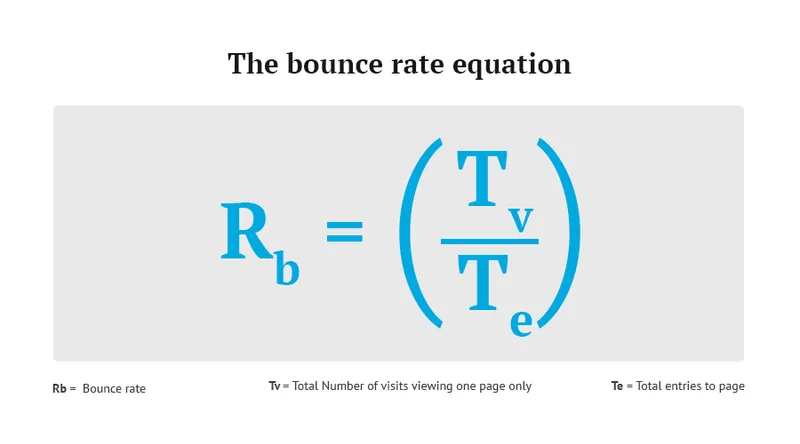
Source: Neil Patel
What Is A Standard Website Bounce Rate For E-commerce?
For e-commerce, the bounce rate is correlated with the rate of purchase conversion.
Lower the number of purchases, higher is the bounce rate.
Bounce rate shows important cues for which product collections and promotions at the category levels of your taxonomy are doing well.
The graph below shows the benchmark bounce rates depending upon different website types including e-commerce and retail websites demonstrate the industry standard. Well, for e-commerce and retail websites, bounce rate between 20% and 45% is acceptable.

Source: conversionxl
While it is difficult to define what is a good bounce rate, you can certainly evaluate it by outpacing the factors that make the visitors bounce off the e-commerce store.
- If the bounce rate ranges between 26-40%, your website is excellent
- If it is ranging from 40-55%, your website is average
- If the bounce rate is more than 70%, your website is non-engaging and needs some strict planning.
You can view bounce rate in the Google Analytics under Audience > Overview section
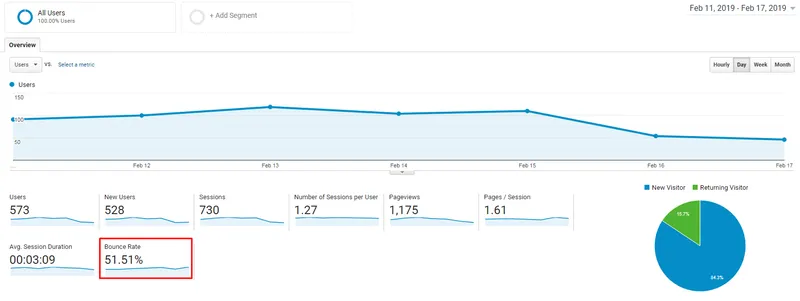
But Why E-commerce Websites Experience High Bounce Rate?
Though there may be many reasons for the elevated bounce rates in e-commerce, below is a list of the common ones.
- Poor website layout
- Uncertain and unfriendly site navigation
- Unappealing and non-engaging web content such as Product or Banner Images, Text Audio, and Video
- Only a few relevant pages on the website
- No Effective Call-to-Action on product landing pages
- Not optimized for mobile devices or other devices other than desktop
- Confusing UX and UI
- No trust symbols used in the website
- High page load time of the landing pages
- Too many intrusive ads or popups intervening with the user experience
High bounce rates can affect your e-commerce stores badly. First, as the users visited a single page and left without making a purchase, it means you failed to convince them for buying your products.
Secondly, more the percentage of users bouncing from your e-commerce website, the worse are your search engine rankings. And when visitors leave after viewing only a single webpage, Google demotes your domain authority.
So, how to overcome these problems, let’s discuss next.
How Personalization can reduce Website Bounce rate for your eCommerce?
To combat high bounce rate, among the many tactics devised by digital marketers, eCommerce personalization stands out as a powerful solution.
Many e-commerce brands are now steering their gears towards personalization. According to a prediction by Gartner, there would be 15% profit boost by 2020 for those who successfully manage personalization in the eCommerce.
But what is personalization in e-commerce?
Personalization in e-commerce is the practice of creating individualized experiences and interactions for customers on e-commerce websites by dynamically displaying content, product recommendation, media, etc. based on demographics, web browsing history and purchases.
To incorporate ‘Personalization’ in their marketing efforts, e-commerce companies focus on factors like the content and other personal features such as automation techniques, artificial intelligence, analysis techniques, and data collection.
12 Powerful Personalization Tips To Reduce Bounce Rate For E-commerce
Let’s dive deeper and discuss the top 12 sure-shot personalization tips to improve your bounce rate, drive sales, and build strong customer relationships.
1. Personalize Search Results
Providing website visitors with a personalized search results experience is a great way to reduce the website bounce rate. Here are some incredible ways to personalize the search results on an e-commerce website:
- Decrease the number of clicks to find products
Let your shoppers see the products that will be most relevant to them with a little effort. You can achieve this by offering a visual experience alongside the search bar itself. Results shown alongside the search bar should be based on the visitor’s true intent, browsing behavior, his past purchases, and the behavior or preferences of people similar to that visitor.
For instance, there’s a user who has visited your website several times and has always browsed men’s clothing but has never purchased anything. When a user begins typing something into the search bar, say with a letter “S”, all the products starting from letter ”S” should be displayed on the website’s search bar based on the collected knowledge about user.
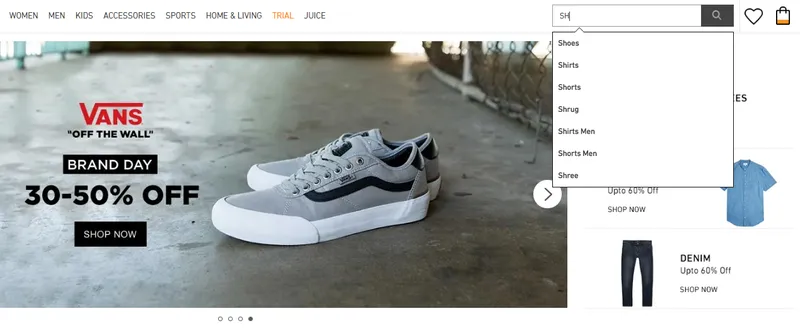
- Creating a custom search results page
You can create a one-to-one personalized collection of products by personalizing the search results page by sorting products according to real-time intent, past behavior, purchases, and preferences of similar visitors.
For instance, if the same user searches for pants, he could be shown both men and women’s pants in the results page. Since he had already shown that he is interested in men’s clothes, so the men’s pants should be displayed prior to women’s to him first. Thus, you are making it easy for the users to find what they are exactly looking for.
- Let the user access the past results easily
Your e-commerce website should make it simple for a user to search for items from a previous search results page even after he has navigated to other product pages. The visitor should be able to find the products of his intention quickly by displaying under “Recently Viewed”.

2. Audience Segmentation - Email Segmentation
More segmented the list of your prospects is, the more personalized your buying experience will be. But what is audience segmentation? The list segmentation is when you group your prospects based on their behavior with your website, products, and emails.
Consider the results generated by the list segmentation of B2C Community, where about 39% of respondents reported that email segmentation increased their open rate and 24% of respondents reported that the email segmentation increased the ROI.
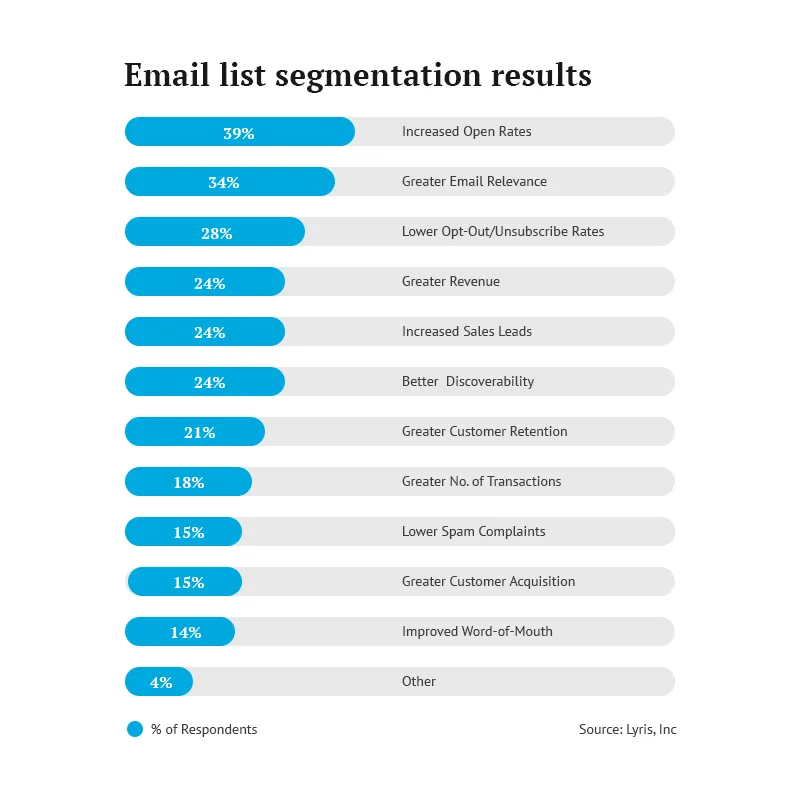
Email segmentation helps you to only send those emails that are quite relevant and interesting to the prospects. Only a specific person receives a specific email. The more segmented your email list is, the better it is. This can let you know which specific product or service will be the most appropriate to send to each group.
Treating all the prospects as same, your bounce rate will only increase. However, your conversion and engagement rate will increase if you segment your email list.
The notion of personalization applies not only to the emails, but also to your website product pages, customer service software, and live chat and messaging.
3. Provide personalized products through E-commerce product designers
Another important tactic is to present your customers with a product customizer option. Implementing e-commerce product designers on your website allows customers to customize the products according to their desire. It also helps you to keep your audience engaged with your website, thus driving more conversions, and improving brand loyalty.
The use of e-commerce product designers largely impact sales and brand prominence.
Here’s an example of basic product designer.

Source: Custom Product designer developed by The Brihaspati Infotech
4. Using exit-intent popups on your e-Commerce website
Getting up to 35% of visitors to sign up, the exit-intent popups have high conversion rates.
An exit-intent popup is a popup that appears only when a website visitor is about to leave your website. Generally, the goal of setting up a popup is to get the visitor to subscribe to your newsletter. Here’s an example:

To push users for entering details, you can include an attractive offer in the popup. For e-commerce stores, this can be a free shipping, discount, or free gift. These pop-ups can be a lead magnet, such as a training course, free ebook, or any other appealing resource.
The exit-intent popups are triggered only when a visitor moves their mouse up in the vicinity of the tab close icon or the browser window. In other words, your visitors are about to bounce, but your website throws one more thing in their way in hopes of saving a sale.
5. Optimize your product pages
Product pages are the main pages when it comes to displaying a product. So, opting measures to optimize these pages become absolutely crucial. Here’s an example of a product page by Walmart:
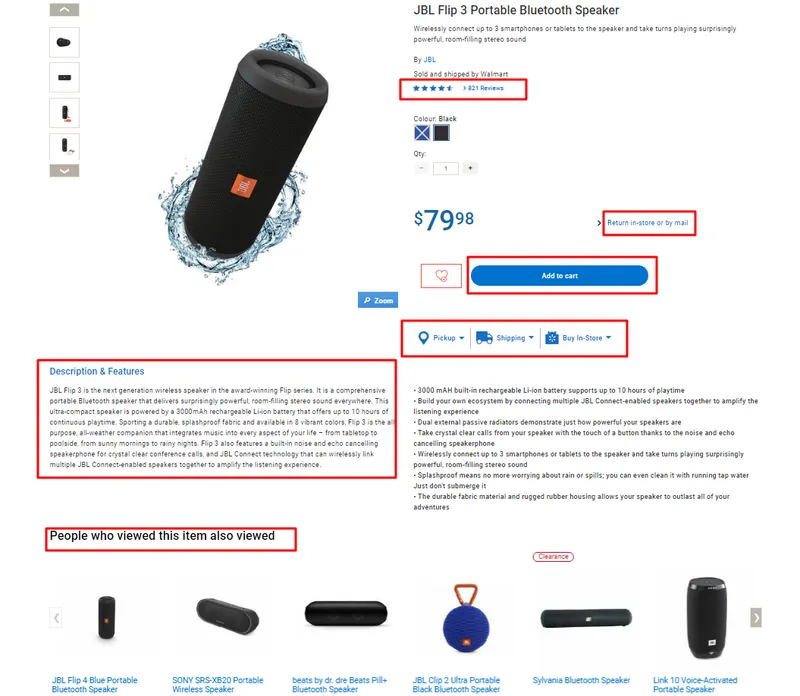
Make sure you provide the following in your product pages:
- High-quality images that are appealing to eyes.
- Write a detailed product description focussing on the features.
- Provide a return and exchange offer.
- Provide additional payment gateways.
- Display the seller name.
- Attractive call-to-action button
- Optimize for product pages
- Increase trust by displaying user reviews and ratings.
- Pitch an Upsell at and after the Purchase.
6. Provide overall seamless purchase experience
Providing a smooth user experience is the key to push your customers for making a purchase. Here are some important tips to include in your ecommerce store:
- Optimizing your e-commerce Checkout experience so that the customers do not abandon the carts. Show the trust signal to gain potential customer’s trust.
- Translate your website content for the international audience.
- Improve the navigation speed between the pages.
- Make all the links open in the external page.
- Write fresh content and Improve the content readability.
- Use the keywords with high-value traffic.
- Make your website cross-platform compatible.
- Invest in a great UI/UX.
- Ensure the mobile-friendliness of your website.
- Optimize the Call-to-action button placement.
7. Using Geo-location services
Another important tactic is using the geo-location services for your eCommerce to redirect your website visitors to the right store. For example, Amazon uses the geo-location services. When a user who purchases from UK’s Amazon.com store now decided to shop from India location, a banner is displayed to choose between UK or India.
Segmenting your e-commerce business to use geo-location is just to keep your customers informed about the shipping availability to their particular location. Implementing the Geo-location services in your e-commerce is a great way to decrease bounce rate.
8. Creating customer journeys
From their very first click on your website to making a purchase, customers walk through certain journeys and you need to guide them to your desired path.
Personalization of customer journeys lead to better customer experience as you provide them with the specific needs that they are searching for.
However, it is important that you deliver right message to the customers at the right time. Most of the messages can get overlooked if sent too early or too late.
Incorporating the ‘Artificial Intelligence’ can help you find trends to offer the right suggestions at right time. AI can help you use customer’s past experiences, collect information about your customers, greet on special days, set triggers based on customer behavior, and more!
Furthermore, with the use of recommendation engines you can display the product a customer is most likely to buy. This type of personalization is essential to ensuring that the digital customer journey is relevant and successful in reducing the bounce rate.
9. Dynamically changing websites
The artificial intelligence based dynamically changing websites are driven by scripts to generate the changing content based on the website visitor’s preferences. This allows the software developers to assign repetitive tasks such as rendering or tagging photos to AI technologies.
To easily implement the dynamically changing websites, there are many softwares offered by the ‘Artificial Intelligence’ companies that enable the less technical-minded individuals or the small business enterprises (SMEs) to develop intelligent websites on their own.
When users are provided with dynamically changing websites, the bounce rate decreases.
10. Implementing 1:1 Profiling
1:1 profiling is a personalisation technique that is based on each customer's unique profile - demographic data, purchase history and more. However, unlike the segmentation, 1:1 profiling uses certain algorithms for creating the dynamic content blocks that change according to each recipient.
This can take the form of:
- Category-specific content based on purchase history of a recipient.
- Dynamic banners displaying discounts which changes depending on the customer profile.
- The content blocks that are time-limited i.e. changing soon after an offer or discount has expired.
- Weather-based content which is accomodating weather conditions. For instance, personalizing the Homepage banner by category. According to evergage, a brand Shoeline personalized their website’s homepage banner to showcase different products based on visitors’ previously demonstrated interests. It is reported that they achieved a clickthrough rate (CTR) of up to 26% and a conversion rate of 18%.
- As an e-commerce merchant, you can provide the product recommendations as an important tool in your arsenal to lower the bounce rate. To execute product recommendation for your customers, you can:
- Recommend product categories based on browsing behavior.
- Show personalized offers to returning visitors.
All these factors make 1.1 profiling the future of personalization.
11. Deliver Weather-Sensitive Personalization
Delivering a seamless user experience is the need of the hour. It is reported that 70% of GDP across the world is affected by the weather. Many e-commerce brands today have started focussing to deliver the weather-sensitive personalization.
While the online retailers being able to adapt the e-merchandising to external weather factors proves to be a real asset. They are capable of satisfying the demands of online users and not missing out the easy sales.
However, adapting the products to climatic conditions is also dependent upon the geographical location of plenty of consumers. This is really a gigantic task which can be achieved with the segmentation solution based on weather conditions.
The weather-sensitive e-commerce retailers can easily promote the messages or offers that are relevant to the online customers based on the forecast or current meteorological conditions specific to their geographical location.
Delivering weather-sensitive personalization includes either integrating the dynamic content within web pages or displaying an overlay for maximum flexibility. Using the function of weather targeting, it is possible to act on information that you already know to influence buyer behavior.
12. Retarget abandoning users
As per statista, the conversion rate of e-commerce sites on an average is around 2.6%. To achieve the growth, remarketing is the ultimate solution. The use of artificial intelligence such as machine learning can help you ensure an effective remarketing.
Using AI, you can trigger conversions with personalized recommendations. Or you can boost the retargeting performance with the help of AI-based Segmentation.
Retargeting provides higher return on investment because it interacts with the specific people who once abandoned your products. So, conversions are more.
Final Thoughts On Lowering the E-commerce Website Bounce Rate
These remarkable personalization tips can help e-commerce businesses to optimize their stores for the reduced e-commerce bounce rate. Lowering the bounce rate ensures better customer engagements with your e-commerce stores.
What is your favorite personalization technique apart from these tips? Do comment below and start the discussion.





